People are like stained-glass windows. They sparkle and shine when the sun is out, but when the darkness sets in their true beauty is revealed only if there is light from within. -Elisabeth Kübler-Ross
Welcome back to The Greatest Story Ever Told, where we're covering the natural history of the Universe from before the Big Bang to the present day. You can catch up on the first eight parts here, going forward from Inflation in part 1 to parts 2, 3, 4, 5, 6, 7, and reaching the formation of the first neutral atoms in part 8. But during all of this time, gravity has been working its magic.
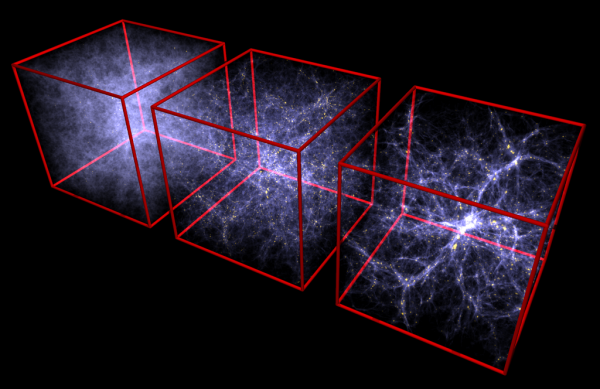
In other words, the Universe started off almost perfectly smooth, with roughly the same matter and energy densities at all points in space. But it wasn't perfectly smooth, there were teeny tiny differences from place to place, just like if you went out to the middle of the ocean and measured how level is the water's surface.

Sure, you might glance at it and say the ocean is flat. But if you looked closely, you'd realize there were tiny crests, where the water's a little higher than average, and tiny troughs, where the water level's a little lower.
Thanks to inflation and quantum physics, we can state that the Universe started out almost exactly the same way. Here's how. The Universe has the same average density everywhere, but every once in a while, you get a quantum fluctuation.
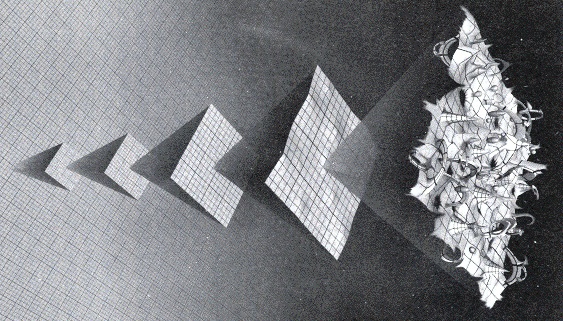
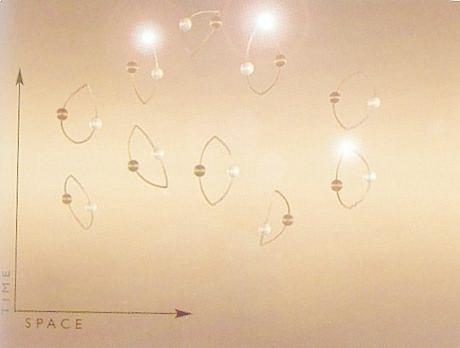
Well, during Inflation, space is expanding exponentially fast! This is so fast that you make these quantum fluctuations, and by time these particles are ready to find each other and disappear again, they're already stretched out across the Universe! And this is, roughly, how tiny quantum fluctuations create regions with slight overdensities and slight underdensities in our Universe!
And gravity works on these over time, attracting more and more matter towards the overdense regions and attracting less and less matter towards the underdense ones. By time you get to the cosmic microwave background and the formation of neutral atoms, some spots appear significantly cooler (shown in blue) due to increased density and others appear significantly hotter (shown in red) due to a deficiency in density.

And then the fun begins. You see, gravitation is a runaway process. If I take a completely uniform Universe and make one region just a tiny bit denser than everywhere else, then everything in the Universe gets preferentially attracted to that region!
So what does this mean for space? It means that the regions where the overdensities live are going to become the places where stars, galaxies, and clusters of galaxies form! What do we owe this to? Gravitational attraction, and eventually, gravitational collapse.
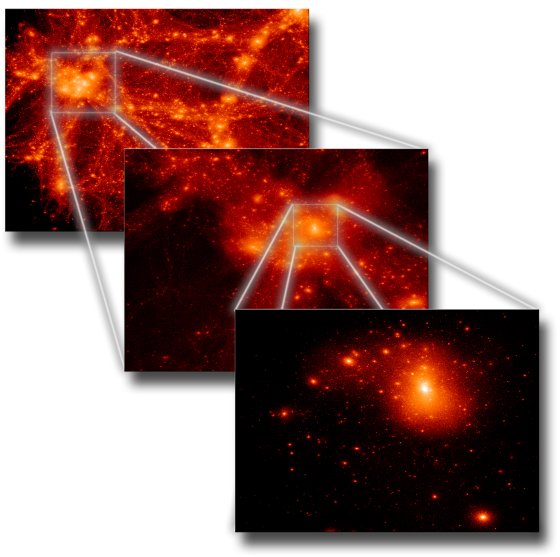
From inflation to the formation of neutral atoms took about 380,000 years. It takes about another 50 million years until you get enough gravitational collapse to make a dense enough gas cloud that the atoms at the center start fusing together. What happens then?
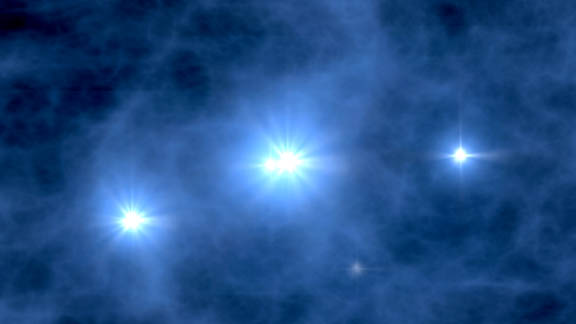
Congratulations! We've just covered how the first star in the Universe formed! And this happens all over the Universe over the next few million years, as the Universe goes from a dark, cool place to one suddenly illuminated by the glow of billions of stars. Want to see a video (courtesy of New Scientist)?

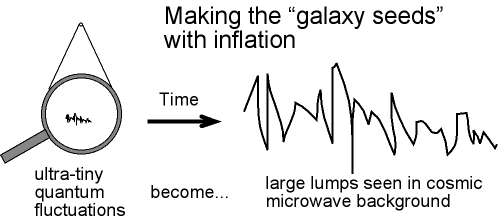
Interesting - I'd never heard of quantum fluctuations being a potential mechanism for the Uncertainty Principle.
This is so fast that you make these quantum fluctuations, and by time these particles are ready to find each other and disappear again, they're already stretched out across the Universe!
So there are regions of anti-particles out there? Did they form anti-particle stars? If you have a particle-anti-particle diad that is separated by inflation so that they can't find each other, then they mustn've have annihilated and their must be dense regions of anti-matter out there. At least, that seems a reasonable inference to draw.
From an observational point of view, one should add that so far, we haven't seen these first stars anywhere - but the James Webb telescope, which will hopefully be launched in 2013, should be able to see them.
your links are broken. I would love to have all the parts of this series organized in order to direct fellow interested parties.
Brando: these particles are not the cause of the uncertainty principle--they are a manifestation of it.
you can show that the uncertainty principle for energy and time can be written as:
âE âT ~ hbar
one interpretation of this is that you can have pairs of virtual particles/antiparticles of energy âE created out of nothing from the vacuum. they pop into existence, hang around, then a short time later they annihilate and are gone.
physics allows this as long as they don't stay longer than âT~hbar/âE seconds.
essentially physics says you can get something for nothing. it's just that normally you can't keep it for very long.
I was wondering if there is any correlation between the creation and maturing of black holes and the increased expansion rate of the universe? Probably the wrong post to ask this question, but it popped into my head this morning while I was shaving...
I really enjoy your blog, its my lunchtime staple!
Michael @4: thanks! The Links are all fixed now.
Tim @6: This was an interesting idea that was thrown around a few years ago by a friend of mine. I actually worked out what the contribution of that was to expansion and published a paper on it (here). It turns out that you *do* affect the expansion rate, but the effects are small in magnitude and don't cause an increase in the expansion rate. Now that I look back on it, it's hard to imagine that was five years ago already.
Didn't you point out before that the "large lumps" in the cosmic microwave background are in fact extremely small variations in the measured radiance?
MadScientist @8,
They are small variations as compared to the average temperature. The CMB is about 2.725 Kelvin, while the fluctuations are a few tens of microKelvins.
But most of the fluctuations would be even considerably smaller in magnitude if gravity hadn't had almost 400,000 years to do its thing!
All those little quantum fluctuations, and all those instantaneous gigantic separations are an over dramatic example of cyclic reasoning posing as logical cause and effect in the support of the "hypothetical inflation theory".
The theory of star formation works very well without any theory of inflation. The theory of star formation does not support any theory of inflation; rather if is independent of any inflationary theory and will fit nicely within ANY theory of the universe. If a theory of the universe has matter; stars will form.
@Thomas:
I see no cyclic reasoning here. Inflation was proposed to solve problems like flatness and homogenity of the CMBR. Then people looked what other predictions inflation makes, and saw that they can predict the shape, distribution etc. of fluctuations in the CMBR from inflationary models. And these predictions were then tested, using the data from WMAP. What is cyclic reasoning about that?
Well, that's essentially right (you only need to explain why the universe isn't *totally* homogeneous, and one can explain that without inflation, too) - but I don't see where in the article above Ethan said that inflation is *necessary* for star formation? He only explained how one explains the observed fluctuations in the inflationary model - nowhere did he say that other explanations aren't possible.
Wow. So that's how stars form.
This is what I like, when even the most complicated things is made very simple.
Thank you language, thank you pictures, and thank you ingenuity and imagination.
COULD SPECIAL RELATIVITY AND INFLATION THEORY BE COMBINED WITH THE UNCERTAINTY PRINCIPLE TO SHOW US HOW QUANTUM FLUCTIONS CAME ABOUT.
Wow!!! This post makes me think about the universe in a whole different perspective. Thanks for make this post easy to understand and the video also is good look as well.
Sorry if I'm throwing in such a newbie question, but do we actually see any current stars or are they all from the distant past due to the speed of light travel?